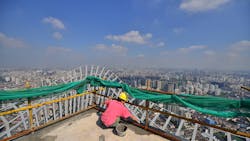Change is a Heavy Task in China’s Industrial Heartland
XINGTAI, China — Rising costs, falling prices, striking workers — iron ore mine manager Song Denggan has a lot on his mind, and chain smokes as he faces the prospect of industrial stagnation in China.
Song’s mine in Hebei, a gritty northern province surrounding Beijing, exemplifies the challenges the country faces as it seeks to move from the factory-driven, fast-growing economy of the past to a consumer-led future.
“There is no comparison between business now and a few years back,” the grey-haired industry veteran said. “The best we can hope for is to remain stable.”
Industries across China are struggling with massive debts and overcapacity, the hangover from credit-fueled expansion that helped drive a decades-long growth party. China’s government says the world’s second-largest economy is expanding at its slowest pace in 25 years — and according to analysts, the real figures could be much lower — and the slowdown has world markets rattled.
Miners at Song’s firm have struggled to increase output in the face of dwindling prices, he said, and have gone on strike over lack of pay, holding a red banner outside the gate reading “We want our wages.”
“We have to maintain production, and even increase it because prices are falling. But our costs are going up,” Song said. “We are feeling the impact of changes in the steel industry.”
It is a pattern repeated across northern China, which is dominated by large, indebted and often state-run firms producing coal, cement and steel. Prices in China’s once-booming real estate sector have remained largely flat over the past year, while overproduction has driven down prices and profits for its suppliers. Some northern Chinese regions expanded by less than 4% in the first half of this year.
Manufacturing data has been dismal in recent months, with activity contracting in August, according to an official purchasing managers index (PMI) survey.
“A lot of the historical industries which China has built heavily on are in flat-out recession,” said Christopher Balding, an economist at Peking University’s HSBC Business School in Shenzhen. “There are large amounts of industries that have enormous surplus capacity.”
‘Overcapacity is Rife’
All this is a far cry from the aftermath of the 2008 financial crisis, when China won plaudits for averting a slowdown by pumping nearly $600 billion into the economy.
But much of the credit — funneled through state-run banks to government firms — fueled wasteful expansion in industries that now suffer from overproduction, analysts say, while debt repayment is crimping growth.
“A lot of Chinese economy activity in the last 10 years has consisted of investments which create a lot of economic activity but not real growth,” Michael Pettis, a finance professor at Peking University, said. Industrial provinces “would like to keep the game going, ... but if you have a lot of debt there’s a constraint on your ability to do that.
“Every country that had a growth miracle has ended up with the same problem. And it’s very hard to resolve.”
Beijing’s master plan is to rebalance the economy, putting more money into the pockets of households whose spending will step in to replace wasteful big-ticket investment.
The need is felt especially keenly in Hebei, which had 286 million tonnes of steelmaking capacity in 2013, more than the entire European Union. But prices for the metal have tumbled, with overproduction pushing some steel values below that of cabbage.
“Overcapacity is rife ... and the need to transform the steel sector is pressing,” local media cited government sources as saying last year.
Replacing millions of jobs in heavy industry is a huge challenge. Officials hope that more profitable high-tech industries can fill the gap, along with service sectors such as tourism and retail.
Those sectors have soared in recent years, with shopping malls dotting Chinese cities and online retailers such as Alibaba booming, while travel is high on Chinese middle-class wish lists. Momentum, though, is slowing and the scale of the substitution is enormous.
“Bringing down investment means closing non-productive factories, and their workers,” Pettis said. “If you fire the workers, consumption will fall.”
‘Wildly Overoptimistic’
Costing 470 million yuan ($73.67 million), local media has billed the “Juran Home” mall in Xingtai, an hour away from Song’s mine, as “accelerating the region’s economic transition.”
“Developing modern service industries is the key to economic adjustment,” they quoted a Communist planning official as saying.
The retail center specializes in home decor supplies such as wallpaper, moldings and furniture, but was nearly empty on a weekday afternoon. There were few customers at weekends either, said Du Zhiyan, 26, who sells woodchip wallpaper.
“My boss isn’t happy, but there’s nothing he can do except lower prices,” she said. “We will need to find new industries or there is not much hope for the city. State firms aren’t doing as well as before.”
Some Chinese service sector measures have been holding up – both official and private services PMI surveys consistently show expansion, and last year the sector grew by 8.4%, against 6.1% for manufacturing.
Poor industrial data “has to be to be set alongside the relatively strong releases that we’ve also seen concerning the service sector,” said Mark Williams of Capital Economics.
“Part of the shift in sentiment towards China over the last couple of months was people realizing that their expectations for China were wildly overoptimistic,” he added.
Even so, the boom days are over for mine manager Song. The market can recover, he said, taking another drag on his cigarette, “but it will never go back to the way it was.”
By Tom Hancock
Copyright Agence France-Presse, 2015
About the Author
Agence France-Presse
Copyright Agence France-Presse, 2002-2025. AFP text, photos, graphics and logos shall not be reproduced, published, broadcast, rewritten for broadcast or publication or redistributed directly or indirectly in any medium. AFP shall not be held liable for any delays, inaccuracies, errors or omissions in any AFP content, or for any actions taken in consequence.
